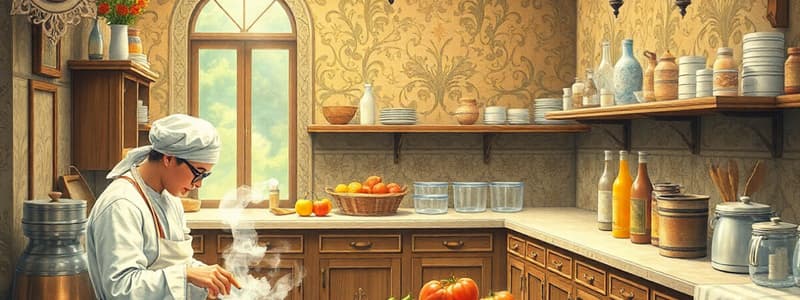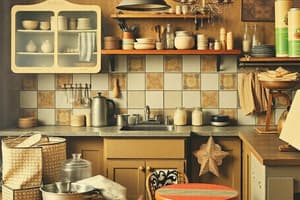Podcast
Questions and Answers
What is the most common way for bacteria to be transmitted from food handlers to food?
What is the most common way for bacteria to be transmitted from food handlers to food?
Unwashed hands and/or soiled single-use gloves.
Describe what is meant by cross-contamination.
Describe what is meant by cross-contamination.
Cross-contamination occurs when raw food is transferred to ready-to-eat food.
For how many seconds should hands be washed before handling food?
For how many seconds should hands be washed before handling food?
A minimum of 20 seconds.
What is the temperature danger zone for food, and why is it important?
What is the temperature danger zone for food, and why is it important?
At what minimum temperature should poultry be cooked to ensure safety?
At what minimum temperature should poultry be cooked to ensure safety?
What temperature should cold foods be held at for safety?
What temperature should cold foods be held at for safety?
What type of towels should be used for drying dishes in the foods lab?
What type of towels should be used for drying dishes in the foods lab?
Which type of towels should be used to sanitize surfaces in the foods lab?
Which type of towels should be used to sanitize surfaces in the foods lab?
Why is it not acceptable to put food debris down the drain in the foods lab?
Why is it not acceptable to put food debris down the drain in the foods lab?
What is the safest approach when a recipe calls for baking something for 14-16 minutes?
What is the safest approach when a recipe calls for baking something for 14-16 minutes?
What is the correct abbreviation for tablespoon?
What is the correct abbreviation for tablespoon?
What is the abbreviation for teaspoon?
What is the abbreviation for teaspoon?
How many cups are there in a quart?
How many cups are there in a quart?
How many pints are in a quart?
How many pints are in a quart?
How many teaspoons are equivalent to one tablespoon?
How many teaspoons are equivalent to one tablespoon?
How many ounces are in a cup?
How many ounces are in a cup?
How many ounces are in one pound?
How many ounces are in one pound?
How many tablespoons are in one stick of butter?
How many tablespoons are in one stick of butter?
If a recipe requires 2 1/2 cups of sugar and you halve the recipe, how much sugar do you need?
If a recipe requires 2 1/2 cups of sugar and you halve the recipe, how much sugar do you need?
After halving a recipe that calls for 1/4 cup of butter, how much butter is needed?
After halving a recipe that calls for 1/4 cup of butter, how much butter is needed?
If you double a recipe that requires 2/3 cup of flour, how much flour will you need?
If you double a recipe that requires 2/3 cup of flour, how much flour will you need?
True or False: Different types of measuring tools can be used for all ingredient types.
True or False: Different types of measuring tools can be used for all ingredient types.
What piece of equipment is used to measure ingredients by weight?
What piece of equipment is used to measure ingredients by weight?
Sifters and rolling pins are examples of what kind of tools?
Sifters and rolling pins are examples of what kind of tools?
What ingredient is traditionally packed into a measuring cup for precise measurement?
What ingredient is traditionally packed into a measuring cup for precise measurement?
Which type of measuring cup is used for liquids?
Which type of measuring cup is used for liquids?
What ingredient would you typically use a liquid measuring cup for?
What ingredient would you typically use a liquid measuring cup for?
What is the term for the process of applying gentle heat to eggs so that they cook through without becoming rubbery?
What is the term for the process of applying gentle heat to eggs so that they cook through without becoming rubbery?
What term refers to the number of servings or items a recipe produces?
What term refers to the number of servings or items a recipe produces?
Which option is NOT a main component of a recipe?
Which option is NOT a main component of a recipe?
Is it recommended to use high heat when cooking eggs? Explain your answer.
Is it recommended to use high heat when cooking eggs? Explain your answer.
What are the two grades of eggs primarily available in supermarkets?
What are the two grades of eggs primarily available in supermarkets?
Identify the tool that is primarily used for measuring dry ingredients.
Identify the tool that is primarily used for measuring dry ingredients.
What kitchen tool is utilized to ensure even cooking temperatures in meat?
What kitchen tool is utilized to ensure even cooking temperatures in meat?
Which type of eggs has a completely set yolk when cooked?
Which type of eggs has a completely set yolk when cooked?
Are perfectly scrambled eggs supposed to show a color variation of yolk and egg white?
Are perfectly scrambled eggs supposed to show a color variation of yolk and egg white?
Which kitchen tool is best for shredding vegetables or cheese?
Which kitchen tool is best for shredding vegetables or cheese?
What is the primary use of a paring knife in food preparation?
What is the primary use of a paring knife in food preparation?
What type of knife is considered most versatile and is commonly used for slicing and dicing?
What type of knife is considered most versatile and is commonly used for slicing and dicing?
Is it true that a dull knife is safer than a sharp knife?
Is it true that a dull knife is safer than a sharp knife?
What kitchen tool is used for chopping and preparing ingredients on a flat surface?
What kitchen tool is used for chopping and preparing ingredients on a flat surface?
Which utensil is commonly used to incorporate air into mixtures like eggs and whipped cream?
Which utensil is commonly used to incorporate air into mixtures like eggs and whipped cream?
Identify the tool that eases the rolling of dough and pastries.
Identify the tool that eases the rolling of dough and pastries.
What kitchen utensil is used for lifting and turning foods such as pancakes?
What kitchen utensil is used for lifting and turning foods such as pancakes?
Which measuring tool would you use to measure a small amount of salt accurately?
Which measuring tool would you use to measure a small amount of salt accurately?
What is the term for a beaten egg mixture that is cooked without stirring and then folded in half?
What is the term for a beaten egg mixture that is cooked without stirring and then folded in half?
What is the term for the soft protein lumps that occur when an egg thickens?
What is the term for the soft protein lumps that occur when an egg thickens?
Describe the process whereby the proteins in eggs change from a liquid state to solid when heated.
Describe the process whereby the proteins in eggs change from a liquid state to solid when heated.
Flashcards
Garbage disposal in food labs
Garbage disposal in food labs
Food debris should NOT be put down the drain. Use the garbage disposal to dispose only of food scraps and not other materials.
Recipe alterations
Recipe alterations
Students should not alter recipes without permission in food labs.
Safe baking time
Safe baking time
When a recipe gives a range (e.g., 14-16 minutes), the safest option is to set the timer for the longest duration mentioned.
Air pods in foods lab
Air pods in foods lab
Signup and view all the flashcards
Tablespoon abbreviation
Tablespoon abbreviation
Signup and view all the flashcards
Teaspoon abbreviation
Teaspoon abbreviation
Signup and view all the flashcards
Quart abbreviation
Quart abbreviation
Signup and view all the flashcards
Cups in a quart
Cups in a quart
Signup and view all the flashcards
Bacteria transmission (food handler to food)
Bacteria transmission (food handler to food)
Signup and view all the flashcards
Cross-contamination
Cross-contamination
Signup and view all the flashcards
Handwashing duration
Handwashing duration
Signup and view all the flashcards
Temperature danger zone
Temperature danger zone
Signup and view all the flashcards
Poultry cooking temperature
Poultry cooking temperature
Signup and view all the flashcards
E. coli destruction temperature
E. coli destruction temperature
Signup and view all the flashcards
Cold food holding temperature
Cold food holding temperature
Signup and view all the flashcards
Food lab dish drying towels
Food lab dish drying towels
Signup and view all the flashcards
Whisk
Whisk
Signup and view all the flashcards
Rolling Pin
Rolling Pin
Signup and view all the flashcards
Tongs
Tongs
Signup and view all the flashcards
Dry Measuring Cups
Dry Measuring Cups
Signup and view all the flashcards
Omelet
Omelet
Signup and view all the flashcards
Coagulum
Coagulum
Signup and view all the flashcards
Albumen
Albumen
Signup and view all the flashcards
Coagulation
Coagulation
Signup and view all the flashcards
Ounces in a pound
Ounces in a pound
Signup and view all the flashcards
Liquid Measuring Cup
Liquid Measuring Cup
Signup and view all the flashcards
Tablespoons in a stick of butter
Tablespoons in a stick of butter
Signup and view all the flashcards
Halving a recipe: sugar
Halving a recipe: sugar
Signup and view all the flashcards
Yield
Yield
Signup and view all the flashcards
What is a recipe's main part?
What is a recipe's main part?
Signup and view all the flashcards
Halving a recipe: butter
Halving a recipe: butter
Signup and view all the flashcards
Doubling a recipe: flour
Doubling a recipe: flour
Signup and view all the flashcards
Cutting Board
Cutting Board
Signup and view all the flashcards
Measuring tools for all ingredients?
Measuring tools for all ingredients?
Signup and view all the flashcards
Colander
Colander
Signup and view all the flashcards
Packing for liquid ingredients?
Packing for liquid ingredients?
Signup and view all the flashcards
Sifter
Sifter
Signup and view all the flashcards
Shredding and nutrient preservation
Shredding and nutrient preservation
Signup and view all the flashcards
Egg Grades
Egg Grades
Signup and view all the flashcards
Recipe Egg Size
Recipe Egg Size
Signup and view all the flashcards
Egg Over Hard
Egg Over Hard
Signup and view all the flashcards
Scrambled Egg Appearance
Scrambled Egg Appearance
Signup and view all the flashcards
Paring Knife
Paring Knife
Signup and view all the flashcards
Chef's Knife
Chef's Knife
Signup and view all the flashcards
Knife Safety
Knife Safety
Signup and view all the flashcards
Chiffonade Cut
Chiffonade Cut
Signup and view all the flashcards
Study Notes
Sanitation
- The most common way bacteria is transmitted from food handler to food is by sneezing and coughing, unclean uniforms and aprons, hair falling into food, and unwashed hands/soiled gloves.
- Cross-contamination occurs when unwashed hands touch food, raw food touches ready-to-eat food, and unsanitary kitchen equipment/utensils touch food.
- Wash hands for a minimum of 20 seconds with soap and warm water before handling food.
Temperature Danger Zone
- The temperature danger zone is between 41°F and 135°F.
- Cook poultry to 165°F for 15 seconds.
- E. coli is destroyed at 155°F for 15 seconds or reheating quickly to 165°F
- Cold foods should be held at 41°F
Lab Procedures
- Use paper towels to clean dishes in the food lab.
- Do not put food debris down the drain, use the garbage disposal.
- Students may not alter recipes.
- When a recipe says 14-16 minutes, 15 minutes is the safe option.
- Do not wear AirPods while cooking.
Measurements
- 1 quart = 4 cups.
- 1 quart = 2 pints.
- 1 tablespoon has 3 teaspoons.
- 1 cup equals 8 ounces.
Studying That Suits You
Use AI to generate personalized quizzes and flashcards to suit your learning preferences.




